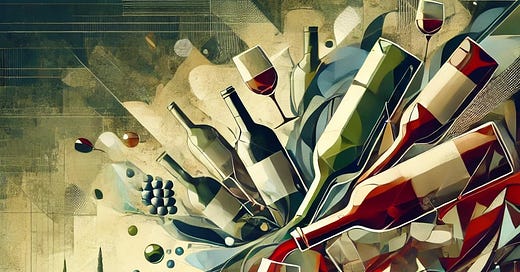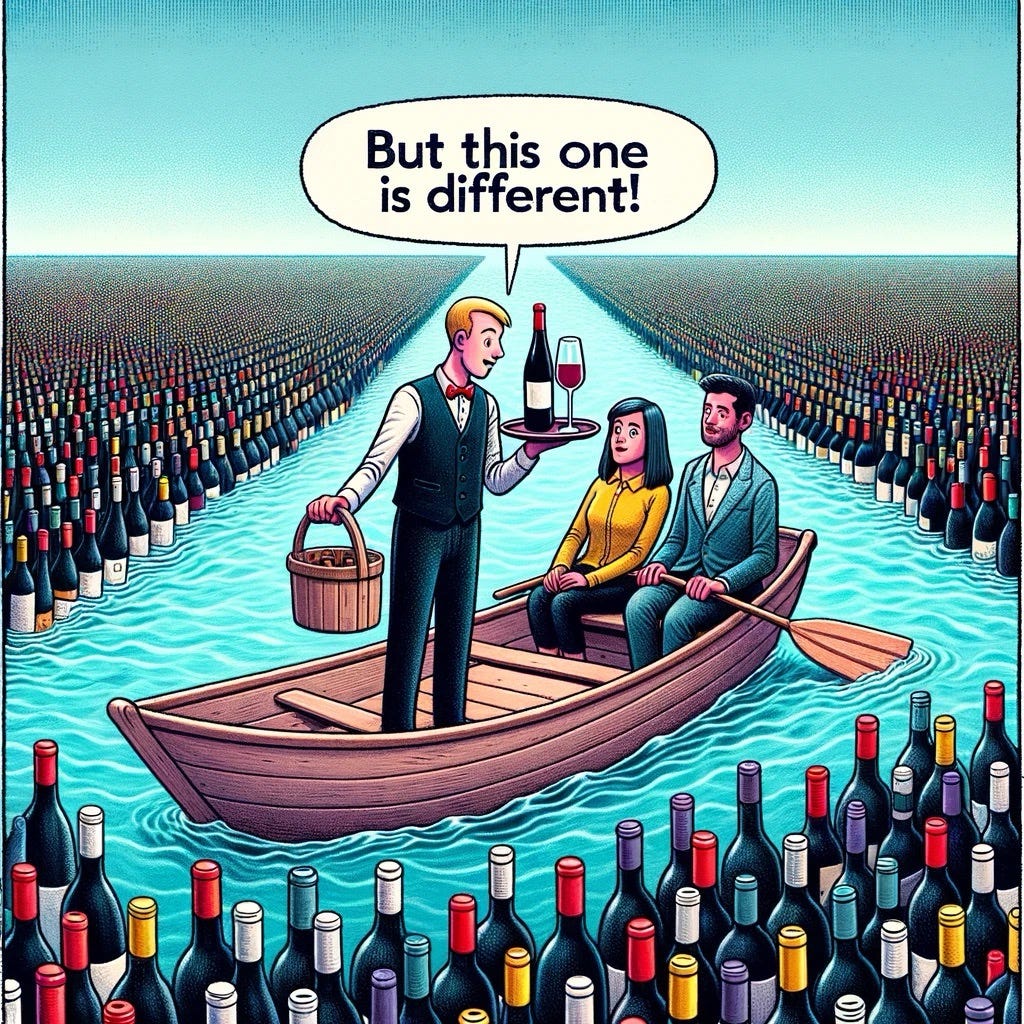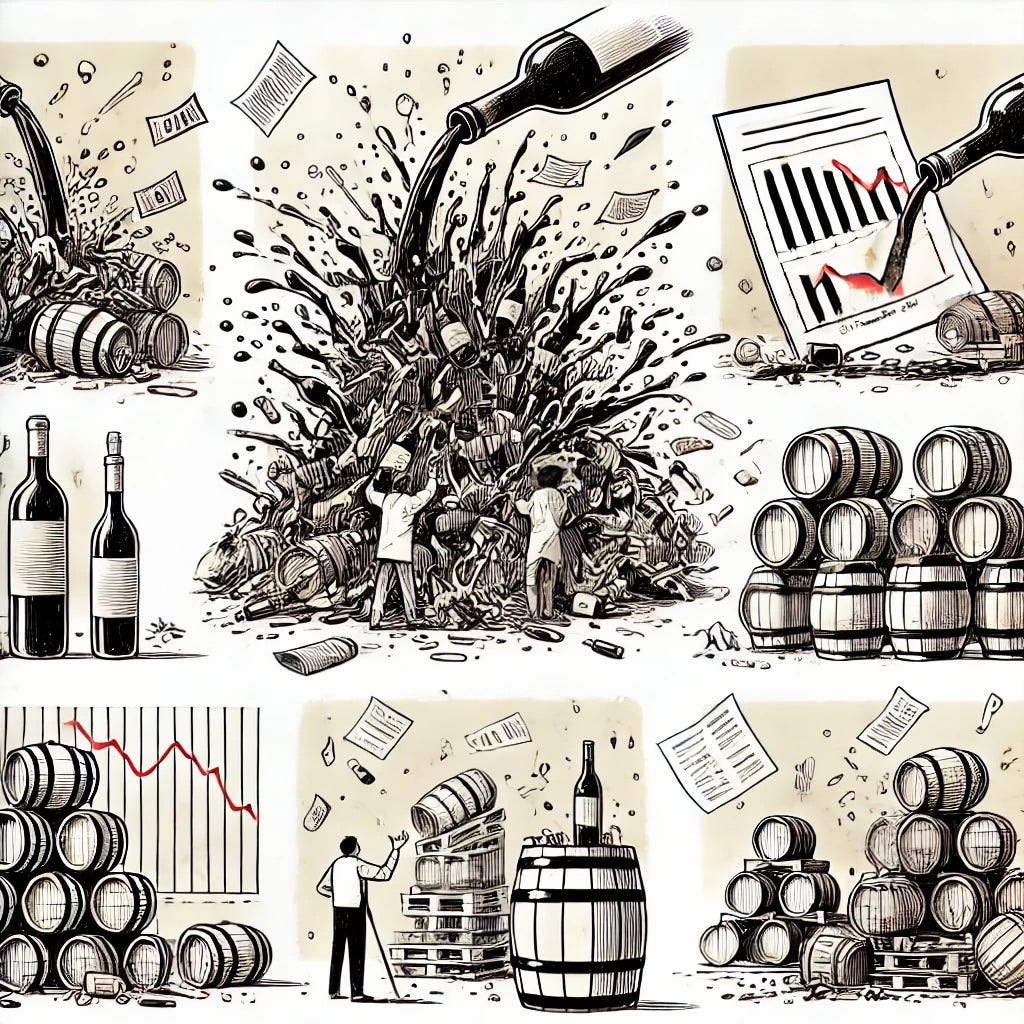NAPA VALLEY, Calif. — There is no question that the current massive sea of wine that exists throughout California poses enormous problems for many wineries. Bankruptcies, canceled grape contracts, business reorganizations, loan defaults and frayed nerves are just a few of the issues facing the California wine business. And predictions are that it will get worse. Moreover, the current period of austerity is not just here. It has affected sales of wine throughout the world.
No one wants to use the phrase “doom and gloom,” but the way things are going, it appears that we face a decade of somberness as well as continued issues that may lead us to an exacerbated situation that will include problems during the harvest of 2025. Not only are neo-Prohibition forces stronger than they have been in two decades, but consolidations at the winery and wholesale levels that once were considered to be standard business practice now are being called catastrophic.
To be sure, the entire wine industry faces a series of problems that haven’t been seen for a long time, and there is plenty of pain and suffering to go around to everyone. However, I’m here to say what I consider to be good news. Some people won’t believe me, but I have been right before.
Within two years, most of us will reflect back on all the 2024 calamities and wonder how it all worked out as well as it did. And I am virtually certain that it will resolve itself by 2026.
It is true that the current situation has not occurred in precisely this manner before, but roughly every generation, or even less, the industry faces similar upheavals, some of which appear to be impossible to solve. When a wine downturn occurs, industry analysts almost always predict that at least a decade of asceticism is inevitable. And yet somehow within two or three years it all works out and the industry finds that homeostasis is built into the system.
In the present crisis, many industry insiders now say that of course correction was absolutely necessary. And although this one seems to be severe, many analysts are not as fretful as you might think.
One truism that I always fall back on: There really is no substitute for a glass of fine wine with lunch or dinner. In fact, dry wine has been with the human race for many thousands of years, and no modern concoctions are likely to replace it any time soon.
One major reason that analysts give for the huge downturn in sales of wine today is that the alcoholic beverage industry has recently developed so many alternative products that now compete with wine. And to be sure, a segment of the public is happy to drink hard seltzer, mocktails, peach-flavored piña coladas, ciders and banana IPAs — as well as a dozen other alternative liquid refreshments.
But will they last? As alternative beverages, the above fabrications may be amusing to some people, but when it comes to having a sip with dinner, these products can’t possibly replace a dry wine. I see them as frivolities.
One of the biggest problems that the wine industry was facing within the last two years was an overwhelming amount of utterly mediocre table wines that were ridiculously overpriced. And I am not talking about high-end cabernets. Those wines have their own separate market and do not affect the greater wine market, which depends on volume to succeed.
Many of the so-called premium wines that were priced to sell for $6 to $10 per bottle were terrible. Better wines at that price niche came from Europe, Chile, Australia and even South Africa. You can fool the public for a time, but eventually ennui sets in, and U.S. wine sales began collapsing.
I spoke last week with a savvy retail wine merchant who has been in the business for more than 40 years and who is at the forefront of wine-pricing creativity. One of his most cogent comments was that “daily consumers” of wine 25 years ago used to spend between $5 and $8 a bottle for their ordinary purchases. For various reasons, including increased discounting, front-line pricing began to rise here while quality began to fall. The price increases weren’t seen as particularly high, but within the last two years, the $7 to $10 segment began to shift upward to about $10 to $14 per bottle. And quality actually began to decline.
Wine has always been a discretionary purchase, and as prices rose and quality dipped, consumers started backing away from what they now considered to be wines that were too expensive – and not as good as they should be.
“We all knew that a shakeout was coming,” said my retailer friend. “It was necessary. But the pandemic interrupted normal buying patterns, and a shakeout really didn’t occur like we all thought.”
The marketplace needed a hiatus, but it was not a particularly good one. Meanwhile, vintages began backing up at wineries, restaurants and in wholesale warehouses.
COVID-19 had a devastating effect on some retail wine establishments, notably those grocery chains that did not offer delivery services. As a result, retail sales slowed to a trickle, and direct-to-consumer sales increased.
COVID-related austerity left many wineries, particularly large producers, with so much perishable wine that huge discounts were necessary. But no one really wanted the product and certainly not in the volumes that were being made available. Recently there have been some remarkable discounts at chain operations. I have tried several of these wines; most of them are terrible.
A few years back, Ferrari Carano Winery offered a fine wine called pinot grigio for sale. It was selling in most locations for nearly $20 per bottle. A few months ago I saw it being closed out at a huge retailer for $7.99.
In January grape-growers were advised by wine-industry professionals that California had approximately 100,000 acres of grapes more than were needed for the foreseeable future. Growers who faced having a difficult time selling their fruit were advised that the best tactic was to tear out their vines. This represented 16% of the 600,000 acres of wine grapes planted in the state.
Just two weeks ago Allied Grape Growers, which represents dozens of growers, suggested that even more acreage should be removed. One industry analyst told me two weeks ago that removal of 100,000 acres would be barely enough to be effective.
“We need to get rid of at least 25% of all the vineyards we’ve got,” he said, “and maybe even more.”
Three of the world’s largest wine-producing nations — Australia, France and Chile — all have removed tens of thousands of acres already, and it is clearly not enough. More removals are anticipated.
In the face of so many negative tales, my prediction that all will be resolved within two years may seem Pollyanna-ish. But the wine business has a way of sustaining itself, and although some stern tactics may be necessary, the industry will survive. Here are a few reasons how:
The shakeout was necessary. Far too many brands were being made available to consumers who had no idea what they represented — if anything — and at prices that were simply far too high for the quality of wines being offered. Once the majority of the inventory that now exists has been absorbed, likely at deeply discounted prices, the industry will get back to more sane pricing practices.
Retail wine merchants may have to take smaller margins for a time to survive. Standard margins must come down. With so much wine to sell, they surely will. Among such tactics may well be discounted shipping charges for direct-to-consumer buyers.
Wineries must rethink their front-line pricing. A Sonoma County winemaker estimated that the actual cost of production of almost all expensive wines ranges between $20 and $40 a bottle. Anything above that is profit. This includes wines that sell for many hundreds of dollars per bottle. He said that tiny producers may have higher per-bottle costs, but their production costs rarely exceed $50 per bottle. As a result, even Napa Valley cabernets can and probably should come down in price. Producers will still make money.
Wholesale companies provide vital services in terms of logistics (warehousing and trucking). But they have proven to be woefully inadequate when it comes to representing smaller brands, many of whom may well reconsider wholesale representation in favor of other sales tactics.
Beverage law experts have predicted for several years that a major change in the mandated antediluvian three-tier distribution system is necessary. This depends, of course, on legislators’ understanding of some of the problems that alcoholic beverage industries have faced for 90 years.
Restaurants must change their markup policies to encourage more diners to choose wine with their meals. Fifty years ago it was common practice for restaurants to simply double the wholesale price, or a bit more, of a wine on its wine list. That meant that a restaurant paying $10 for a bottle (wholesale cost) would charge $20 or $23 to diners.
In the last few decades, restaurant margins have risen so ludicrously that the same $10 wholesale wine is now $30 to $40 (and more), with restaurateurs making the assumption that most consumers won’t notice what a rip-off it is. And wines that sell for as little as $10 typically are astoundingly ordinary and frequently do not go with food.
But diners may notice rip-off pricing. Most of us carry cell phones. Savvy diners who see a wine on a list for $80 might be perturbed to discover from an internet search that a local retailer was carrying the same wine for $20.
Restaurants now face a backlash from consumers who can’t afford to dine out as often as they once did, which cuts into wine sales. A news article last week from The Associated Press said that dining at Darden Restaurant Group’s Olive Gardens had dipped 1.1% thus far this year.
Wineries must stop being complicit in a labeling scam. Some wineries create labels that seem to be one thing but are not. There is nothing illegal about this. It is simply unethical. And the quality of the lookalike wines rarely is equivalent to the primary brand.
Restaurants that now impose outrageous corkage charges on patrons who bring in their own wines should consider reducing corkage fees or eliminating them, at the very least on weeknights, to encourage wine collectors to dine on nights that are typically slow.
(I once suggested to the owner of a Los Angeles restaurant that he establish a “loyalty club” for locals who dined regularly. His upscale “natural foods” café was casual, but the list had a few excellent wines at slightly elevated prices. The loyalty club patrons would be offered free corkage and discounts on wine-list offerings on weeknights. He never tried the concept out.)

Most of the above ideas are not particularly radical. Nor are they intended to be long-term solutions. Most of them will be easy to test to determine if they produce the intended results. Frequently they do — and in ways the owners might never have imagined. Those that prove to be really successful might be retained. Others could be abandoned as the economy changes.
As an example, one casual Sonoma County restaurant used to charge $10 per bottle corkage. Because it was in Wine Country, the place was popular with winemakers, winery workers and others connected to the industry.
Although the corkage charge was reasonable, the owner decided to test a theory. To determine if eliminating the corkage charge encouraged more diners to bring in unreleased wines, he dropped the corkage charge. After a time, he waived it permanently because business had picked up, especially among winery workers.
The 2024 harvest has brought extreme hardship to many growers and wineries in the north coast. Some growers will not even break even this year. (Some have crop insurance.) But if existing wines can find their way into retail and restaurant channels relatively quickly, some financial analysts say that a rebalancing of the industry is likely shortly after next year’s harvest. That is far more optimistic than anything else I have read.
However, there are a couple of additional factors that pose a more serious problem for premium regions such as the Napa Valley. One is the use of truly mediocre fruit to make cabernets and red blends that are selling for hundreds of dollars per bottle and are not worth the money. Some of these wines will prove to be so mediocre that they could leave a black mark on the area for decades.
Also, exorbitant fees at Napa tasting rooms have already proven to be detrimental to tourism. Anecdotally I have heard of wineries discussing new strategies for how to handle this delicate situation.
I remember many of the downturns that hit the California wine industry in decades past. Most of the time the difficult periods were transitory.
If today’s story captured your interest, explore these related articles:
Dan Berger’s Wine Chronicles: Proof That Napa’s Older Cabs Can Age
Dan Berger’s Wine Chronicles: Napa and Sonoma as True Vinous Siblings
Dan Berger’s Wine Chronicles: The Nostalgia and Nonsense of Barrel Tastings
Dan Berger’s Wine Chronicles: The Evolution and Art of Winemaking
Dan Berger’s Wine Chronicles: How Wine Is Packaged Can Affect Its Quality
Dan Berger has been writing about wine since 1975.
The views, opinions and data presented in this article are those of the author and do not necessarily reflect the official policy, position or perspective of Napa Valley Features or its editorial team. Any content provided by our authors is their own and is not intended to malign any group, organization, company or individual.








Well done. I would add to the current wine industry's woes interest rates and inflation costs. Remember James Carville's famous statement years ago "It's the economy, stupid". The sun will come out tomorrow and I am with you on 2 years.
When I first moved to Napa, I was surprised at how much wine people consumed. It was a daily occurrence, at every event, etc. That was 35 years ago. Not true anymore. I no longer drink, and most of my friends have only an occasional glass of wine. My adult children, in their late 30’s., rarely drink a glass of wine and usually it’s with a meal. It’s no longer assumed that wine will be served at meals when dining with friends. However, the seltzers and beers seem to be popular with the younger folks. This is just what I am
Seeing….out here outside of the wine world.